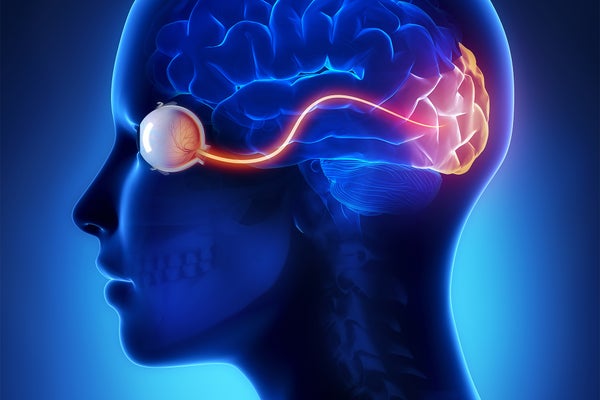Dreams have fascinated people for millennia, yet we struggle to understand their purpose. Some theories suggest dreams help us deal with emotions, solve problems or manage hidden desires. Others postulate that they clean up brain waste, make memories stronger or deduce the meaning of random brain activity. A more recent theory suggests nighttime dreams protect visual areas of the brain from being co-opted during sleep by other sensory functions, such as hearing or touch.
David Eagleman, a neuroscientist at Stanford University, has proposed the idea that dreaming is necessary to safeguard the visual cortex—the part of the brain responsible for processing vision. Eagleman’s theory takes into account that the human brain is highly adaptive, with certain areas able to take on new tasks, an ability called neuroplasticity. He argues that neurons compete for survival. The brain, Eagleman explains, distributes its resources by “implementing a do-or-die competition” for brain territory in which sensory areas “gain or lose neural territory when inputs slow, stop or shift.” Experiences over a lifetime reshape the map of the brain. “Just like neighboring nations, neurons stake out their territory and chronically defend them,” he says.
Eagleman points to children who have had half their brain removed because of severe health problems and then regain normal function. The remaining brain reorganizes itself and takes over the roles of the missing sections. Similarly, people who lose sight or hearing show heightened sensitivity in the remaining senses because the region of the brain normally used by the lost sense is taken over by other senses.
On supporting science journalism
If you're enjoying this article, consider supporting our award-winning journalism by subscribing. By purchasing a subscription you are helping to ensure the future of impactful stories about the discoveries and ideas shaping our world today.
Reorganization can happen fast. Studies published in 2007 and 2008 by Lotfi Merabet of Harvard Medical School and his colleagues showed just how quickly this takeover can happen. The 2008 study, in which subjects were blindfolded, revealed that the seizing of an idle area by other senses begins in as little as 90 minutes. And other studies found that this can occur within 45 minutes.
When we sleep, we can smell, hear and feel, but visual information is absent—except during REM sleep. About 90 minutes after drifting off to sleep, you enter REM. It begins when neurons in your brain stem, the stalklike section at the bottom of the organ, signal the beginning of two important tasks. Activity of these neurons, for one, paralyze major muscles, preventing the sleeper from acting out what is happening in the dream. Also, these brain cells send messages directly to the visual cortex, which initiates the dreaming process.
Why does REM follow that timetable? It conforms to when the visual cortex needs to start defending its territory, Eagleman argues. Scans of dreaming people show most of the brain activity associated with REM is within the visual cortex. Dreams are the brain’s way of fighting takeover from other senses, according to Eagleman, and REM activation prompts internally generated activity in the visual cortex as a means to safeguard its territory. As long as the neurons in the visual cortex are actively performing their customary job—in this case, generating visual imagery—they will not be commandeered by nearby neurons that process other sensory information.
Eagleman argues that the more plastic the brain, the more REM sleep is necessary to mount a defense. For babies to develop properly, they must sleep a lot, spending almost 50 percent of their time in REM sleep. But as people age, their brain becomes less flexible. (Think of how easily children learn languages, compared with adults.) At the same time, adults spend less time in REM sleep.
The correlation between adaptability and REM seems to hold across species. According to Eagleman, “Mother Nature drops human brains into the world half-baked and lets experience take over and shape them.” He argues the less hardwired a species’ brain is at birth, the more ability it has to adapt and learn from experience. But this has its disadvantages. For example, fawns and calves are able to walk within hours of birth because the behavior is hardwired. Human babies, with their more adaptable brains, require significantly more REM sleep than animals born with more hardwired brains.
Some researchers—in particular, dream researchers—disagree with Eagleman’s hypothesis. One example that raises doubts is the fact that the blind mole rat does not see and still experiences REM sleep. Yet some evolutionary adaptations are vestigial remnants of traits that were useful in the past but have become less significant as animals have evolved. So perhaps there was no pressure for blind mole rats to lose REM activity as they evolved without vision.
Antonio Zadra, a dream researcher at the University of Montreal, claims Eagleman’s theory “has little to do with actual dreaming and explains almost nothing about dreams per se, as opposed to REM sleep.” He asserts the theory “is, for me and many others who actually work in the field, silly and overly reductionistic and simplistic.”
Deirdre Leigh Barrett, a psychologist at Harvard University, former president of the International Association for the Study of Dreams and author of The Committee of Sleep, however, is more willing to consider Eagleman’s hypothesis. “It’s very convincing that there's a correlation between smarter animals and more elaborate brains,” she says. As far as dreams defending brain real estate, “I have a little more trouble with the visual argument, but it’s interesting.”
Eagleman says that his theory can accommodate other explanations for dreams and that REM sleep may serve many purposes besides protecting the visual cortex. Think of dreaming like a computer screen saver that is set to go off every 90 minutes—except that instead of protecting against frozen images, dreams prevent the visual cortex from being usurped by other functions. These visual hallucinations in the night may let us see during the day.
